Insulation of an attic roof: detailed instructions on installing thermal insulation in the attic of a low-rise building
High-quality insulation of the attic roof is necessary if the room is intended to be used in winter. It is not necessary to call specialists to perform thermal insulation work. All stages of attic insulation can be carried out independently. Do you doubt what will happen? We will help you solve this problem.
In the article, we provided practical recommendations for choosing the optimal material and outlined the specifics of roof insulation from the outside and inside of the room. In addition, we described in detail the technology of work using the two most popular thermal insulators: mineral wool and polystyrene foam.
The content of the article:
General information about the process
More often the attic is insulated from the inside after the main roofing work has been completed. Thermal insulation material is laid in the space between the rafters, after which the decorative finishing of the room is carried out.
It is permissible to install a layer of insulation on top of the rafter system as part of the roofing pie, but this is an option associated with certain difficulties. There is a high probability of the thermal insulation material getting wet; it will have to be constantly covered with something, and this is inconvenient.
This method is preferred only in cases where the rafters are left visible as part of the original interior.
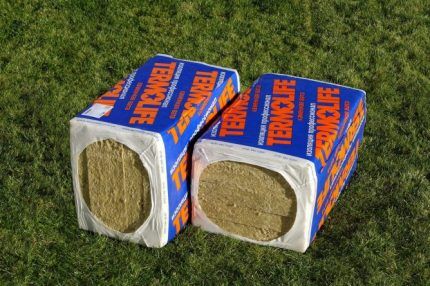
If you just need to make a warm attic, it’s easier and faster to carry out interior work.They are performed after the roof installation is completed. When work needs to be done in a house that has been built a long time ago, there is no choice; you need to insulate the attic from the inside.
The list of materials suitable for attic insulation is quite wide; the most popular heat insulators include:
- rolled materials — mineral stone wool, glass wool;
- slabs - polystyrene foam, extruded polystyrene foam.
The thickness of the insulation is selected depending on climatic conditions. Typically, for the southern regions, a layer of 100 mm is sufficient; in the temperate zone, the amount of material can be increased to 150 mm, and in areas with a harsh climate, at least 200 mm of thermal insulation will be needed.
You should also focus on the characteristics of the specific material chosen for finishing, as well as the features of the cladding. For this purpose, plywood, boards, plasterboard, OSB, MDF, cork, lining, etc. are used. You can use online calculators to perform calculations.
The most common choice when insulating an attic roof:
- Styrofoam — it weighs less, it practically does not get wet, does not blow, but is sensitive to ultraviolet radiation and can catch fire in a fire;
- mineral wool - completely fireproof, but requires maximum protection from moisture and wind.
Mineral wool insulation is easier to cut into separate pieces; it recovers after compression, although serious mechanical loads in this case are contraindicated.
How to use mineral wool?
Insulation using this material is carried out as follows:
- Measure the distance between the rafters.
- Cut the thermal insulation material into pieces of suitable size.
- Perform markings for fasteners on the rafters.
- Mount the brackets under the metal profile.
- Install the profile to check its position.
- Correct the position of the brackets and remove the profile.
- Insert pieces of mineral wool into the space between the rafters.
- Cover the laid insulation and rafters with another layer of mineral wool in a roll.
- A metal profile is installed to fix the position of the insulation.
- Double-sided tape is glued to the profile.
- The vapor barrier membrane is fixed to the tape.
- Tape the joints with single-sided tape.
At this point, the insulation work can be considered complete, you can install drywall, lay electrical cable, perform decorative finishing, etc.
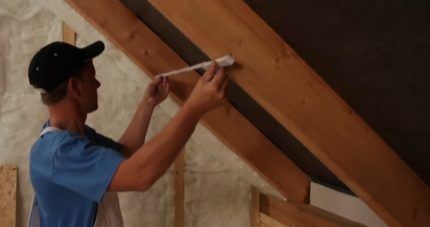
Before insulating the attic roof from the inside, the roll of cotton wool should be unrolled and left for a while. During storage and transportation, some air escapes from the material and it becomes slightly thinner than stated.
You need to let it lie on a flat surface so that its original characteristics are restored. You can measure pieces of mineral wool with a regular tape measure; a construction meter will also work. You will need a sharp knife to cut.
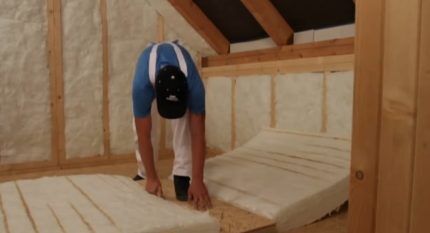
From the windbreak to the marking line for the brackets, you need to leave a distance that corresponds to the thickness of the insulation. Between the rows of these elements a step of 400 mm is usually maintained.
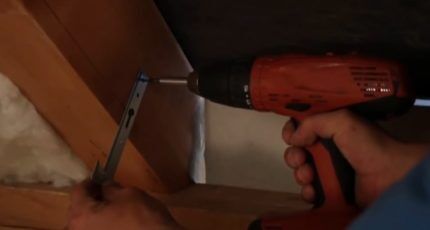
Between the edge of the bracket and the lower edge of the roofing pie, you need to leave a space that is equal to twice the thickness of the insulation. This will be enough to lay the material without crushing it.

After the profile is removed, the laying of pieces of mineral wool begins. It should fit into the space evenly and tightly. Gaps and distortions are unacceptable.
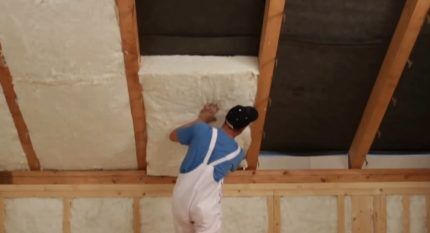
Now you need to take a roll of thermal insulation material and roll it out. It also wouldn’t hurt to give it some time to “lie down” to restore its lost shape. A layer of insulation is used to cover both the existing heat insulator and the ends of the rafters.
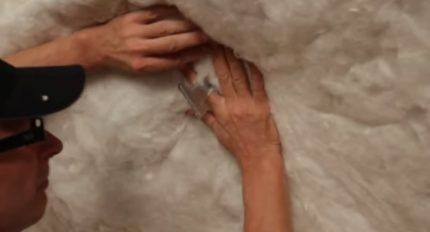
After this, you need to fix the position of the insulation. To do this, the metal profile is fixed to brackets.

Next you need to install a vapor barrier film. To keep it on the profile, just use double-sided tape. The material is laid overlapping; it is important that it lies flat everywhere, without distortions or folds.
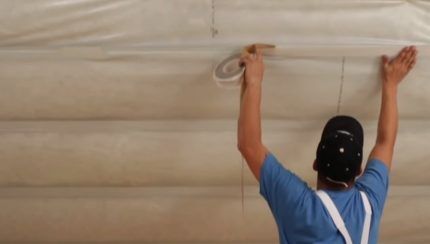
The corners of the room deserve special attention; these are difficult places. Here it is recommended to put another layer of film. To fix it, use a construction stapler and tape.
To prevent pieces of mineral wool from sagging during installation, it is recommended to additionally fix their position using nylon thread. Thin copper wire will also work. This recommendation is also useful when using pressed cotton wool, which initially holds its shape, but later tends to deform.
To increase thermal efficiency, you can use not one thick layer of cotton wool, but two thin ones. The vapor barrier membrane must face the rough side towards the inside of the room, otherwise the insulation will be exposed to condensation.
A counter lathing with a thickness of about 25 mm must be laid on the vapor barrier film to ensure normal air circulation and moisture evaporation.
Procedure for working with foam plastic
The following series of operations can serve as a description of how to insulate an attic roof with polystyrene foam:
- The insulation sheets are cut according to the dimensions of the space between the rafters.
- The foam is installed in place and fixed using polyurethane foam.
- Install the second layer of foam.
- All joints are re-treated with polyurethane foam.
After this, you can begin laying communications and finishing the room. Although the scheme looks simpler compared to insulating an attic with mineral wool, increased demands are placed on the quality of work.
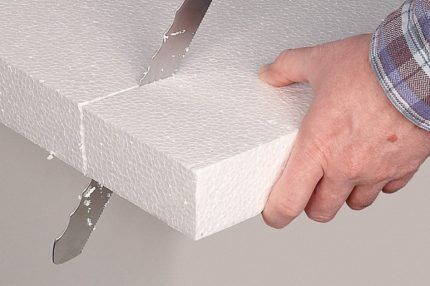
It is very important to use polyurethane foam correctly. It is blown into the places where the insulation meets the rafters, as well as at the joints between individual sheets. After application, you need to wait about five minutes, only then press the next element.
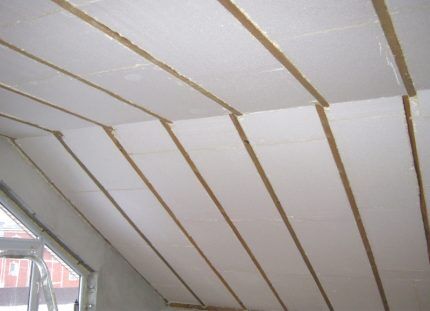
After hardening, the protruding foam is cut off with a knife. Before laying the next layer of polystyrene foam, all edges and joints on the already installed insulation are treated with polyurethane foam.
After waiting the required time, the second layer is simply pressed against the first. Sometimes additional foam is applied to improve the adhesion of the layers.
The foam layers should fit as tightly as possible and the joints should not overlap to prevent heat loss and condensation.
After this, all joints around the piece of foam are re-blown with foam. Good sealing is the main requirement for foam insulation.
The Mauerlat at the junction with the rafters deserves special attention. Here it is recommended to use foam generously to ensure proper sealing of this moving element.

Working with polystyrene foam is easier than working with mineral wool. The use of polyurethane foam allows you to complete all the work on insulating the attic roof of a private house much faster. But don't rush to the detriment of quality.
If there is a gap between the layers of insulation, moisture will penetrate there, and this over time can lead to damage to the rafter structure.
Features of the use of other materials
Extruded polystyrene foam is a good but more expensive replacement for polystyrene foam. It is available in the form of slabs. You can purchase elements with a stepped end, which will provide an exceptionally tight connection.
Plates extruded polystyrene foam They are not placed between the rafters, but mounted on top of them. The material is fixed using various adhesives or self-tapping screws with an enlarged telescopic cap.
Simple installation helps reduce the time required to complete the work, but you should remember the flammability of polystyrene foam when installing electrical wiring.

Glass wool the installation technology is similar to mineral wool insulation. But working with such material is more difficult, since you will need protective clothing to protect your skin from the irritating effects of glass fiber. You will also need a protective face mask; contact of glass wool with mucous membranes is undesirable.
Ecowool - an interesting option for insulation.This is a safe and effective material that is applied to the space between the rafters. But the work will be quite expensive.
Foamed polyurethane foam provides exceptionally reliable insulation. It is applied in a continuous layer without seams. But it is difficult to carry out such work on your own, since this requires equipment and trained personnel.
A detailed overview of thermal insulation materials with a description of their advantages and disadvantages, as well as additional tips on choosing insulation for an attic roof, are presented in this article.
Conclusions and useful video on the topic
Insulation with mineral wool from the inside:
How to insulate an attic roof with foam plastic for winter living:
To insulate the attic correctly, you should select the appropriate material and strictly adhere to the work technology. High-quality insulation will not require replacement for 30-50 years or longer. But errors when laying the material can lead to damage not only to the insulation, but also to the entire roof.
Share with readers your experience of insulating an attic roof. Tell us what the choice of insulation was based on, what installation technology you followed. Please leave comments on the article, ask questions and participate in discussions. The contact form is located below.



